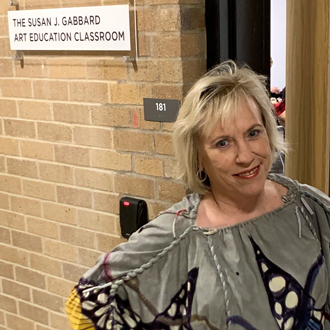
Susan J. Ellis Gabbard
1970, B.A., Art Education, 1994, M.A., Art Education
Art Education Consultant, Oklahoma City, Okla.
CVAD Advancement Board Member
Instagram: SJGabbard
LinkedIn: Susan J. Ellis Gabbard
Would you tell us a bit about yourself?
I am a lifelong art educator. My career in art education began with my first teaching job in San Antonio from 1971 to 1974 at Charles C Ball Elementary. I taught in two private schools in Oklahoma and three other public school systems: Norman Public Schools, Carrollton-Farmers Branch, and Oklahoma City Public Schools. I was invited to work on a curriculum guide as a young teacher in SAISD by the Coordinator of Fine Arts, Elizabeth Kefauver. The section I contributed to was "Classroom Management," about orientation, student participation, leadership, and the arrangement of the art room — mounting and displaying artwork. I went on to contribute to or write my own curriculum guide at all the schools I worked in. I also worked at the state level on curriculum writing in Texas, Oklahoma, and the national level. I fell into leadership in Oklahoma when I volunteered to work with the Youth Arts Month committee at my first Oklahoma Art Education Association annual conference. That put me on the OAEA board, where I was elected president. I also served on the Texas Art Education Association board as the first Middle-Level Division director. That happened after a group of us who were attending the National Art Education Association convention found ourselves feeling left out, as there was no middle-level division director, only a "Secondary" division person. We felt like middle school needed its own division, so we decided to go back and start a division in the states we were from and hoped that, eventually, NAEA would follow suit and create a division. A year or so after it was brought up at the NAEA Delegates Assembly annual meeting, the NAEA Board of Directors approved it. I was fortunate to be able to serve in leadership positions throughout my teaching career, eventually as the NAEA Western Region Vice President and then as NAEA President from 2005 to 2007. I was on the committee to review and write the new National Standards for Visual Art. After my 30 years in the classroom, I went to work as the Visual and Performing Arts Director for Oklahoma City Public School for 10 years for all the music, theater, dance, and visual arts programs for K-12. When I retired at the end of 2014, I served on the board of a fine arts charter high school, serving as board president for four years.
Has there been a defining moment in your professional career or a particular moment in your career that meaningfully altered your trajectory?
Mentoring is especially important. I’ve had several mentors in my life, but the most important one was a woman who was the OAEA President, Jo Ann Adams, when I was a new young member. She invited me to my first NAEA convention, which was held in Dallas. She had a conflict and asked if I would “sit in” for her in the States Assembly meeting and take notes. That group later became known as the Delegates Assembly, which was all the state art education leaders meeting at the annual NAEA convention. As I observed and learned about NAEA, I was impressed by the Western Region VP, who was a woman from Texas. As I talked to Jo Ann about her, she said to me, “You could do that, Susan.” I had never thought that, but her encouragement helped me think that maybe I could be in that leadership position. So, I learned from Jo Ann how important it is to encourage people who have the skills to seek to learn more about leadership and volunteering. I am happy to say that several teachers and friends of mine have become successful leaders. That is important for your peers and students in your classroom.
Parents are often skeptical about having their child major in an art or design-related field. Was that true for you? What did you do to change their mind?
My single-parent mother was not so worried about my interest in visual arts, as she loves art. She always said to get a teaching certificate because I could “always fall back on it” to make a living for myself. While I had this idea, I wanted to be a flight attendant. However, back in the 1960s, you had to be a certain height and weight to get into that program, and I was too short. I wanted to travel. I have traveled to many states and cities as well as abroad through my connection with NAEA by attending national conventions all over the country and going to most of the states for various meetings. I’ve also been asked to lead art teachers through the People-to-People Ambassador program to Beijing; Saint Petersburg, Russia; Vietnam and Cambodia. I was awarded a Fulbright Teacher Fund scholarship and spent three weeks in Japan learning about their education system and touring all levels of schools. My mother was very thankful and proud of all my accomplishments.
What aspects of art do you feel are the most important to communicate to audiences you engage with?
Visual art has been around since the beginning of time, and it is basic for humans to communicate through pictures, drawings, signs, and images. Visual art takes many forms, and new ideas are evolving daily.
